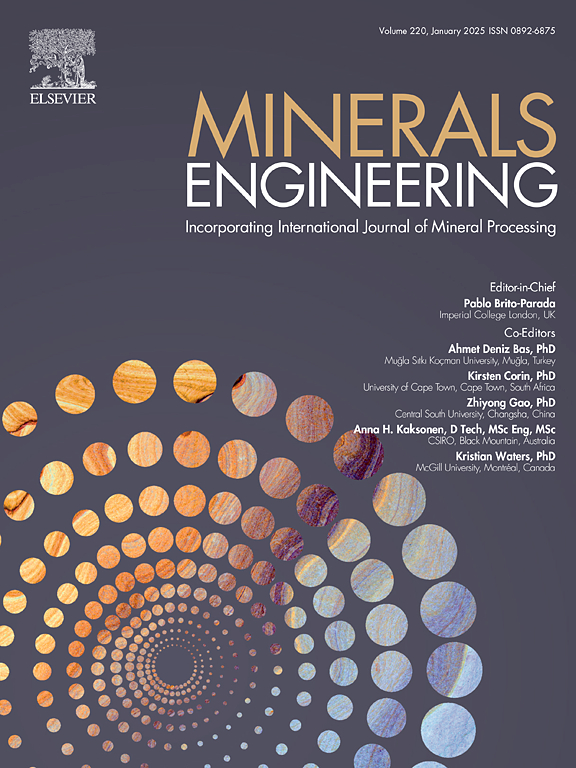An optimized recovery of cobalt and tungsten carbide (WC) from a binary-phase WC-6 wt%Co cemented tungsten carbide hardmetal using design of experiments
IF 4.9
2区 工程技术
Q1 ENGINEERING, CHEMICAL
引用次数: 0
Abstract
Tungsten extraction from scheelite and wolframite ores is a well-established process. However, continuous exploitation has led to more complex ore compositions and lower WO3 concentrations in tungsten concentrates, posing significant challenges for sustainable extraction. Primary and secondary tungsten sources often contain valuable metals such as Sn, Ta, Nb, Mo, Sc, and Co; however, current industrial processes focus predominantly on tungsten recovery, neglecting other metals and compromising sustainability. This study aimed to develop a process for the co-recovery of tungsten carbide (WC), cobalt (Co), and tungsten (W) from cemented carbide scrap using a sulphate-based leaching system. A statistical Design Of Experiments (DOE) approach was employed to screen and optimize process variables, including acid concentration, leaching time, solid-to-liquid ratio, temperature, and agitation rate. Characterization revealed the material contained 85.95 wt% W, 8.77 wt% C, and 5.28 wt% Co. Optimal leaching occurred with 2 M H2SO4, a 1:10 S/L ratio, at 82 °C, and 750 rpm agitation, achieving 25.13 % Co extraction in 10 h and 97.6 % after 4.2 days. Increasing the temperature to 92 °C improved extraction, reaching 31.7 % in 10 h. Temperature was identified as the primary factor influencing cobalt dissolution kinetics. The recovered WC powder consisted of well-defined, fine particles comparable in quality to ‘virgin’ WC. Electroplated cobalt achieved 91.9 % current efficiency over 3 h, producing metal with 98.0 wt% purity and good morphological integrity. Synthetic tests confirmed that tungsten recovery as scheelite (CaWO4) is highly feasible.

利用实验设计优化了从WC-6 wt%Co硬质合金中回收钴和碳化钨的工艺
从白钨矿和黑钨矿中提取钨是一种成熟的工艺。然而,持续开采导致钨精矿中矿石成分更加复杂,WO3浓度降低,对可持续开采提出了重大挑战。一次和二次钨源通常含有有价金属,如Sn、Ta、Nb、Mo、Sc和Co;然而,目前的工业过程主要集中在钨的回收,忽视了其他金属和损害可持续性。本研究旨在开发一种利用硫酸盐基浸出系统从硬质合金废料中共同回收碳化钨(WC)、钴(Co)和钨(W)的工艺。采用实验统计设计(DOE)方法对酸浓度、浸出时间、料液比、温度和搅拌速率等工艺参数进行筛选和优化。表征表明,该材料含有85.95 wt% W, 8.77 wt% C和5.28 wt% Co。最佳浸出条件为2 M H2SO4, 1:10 S/L比,82°C, 750 rpm搅拌,10小时内获得25.13%的Co提取率,4.2天后达到97.6%。温度升高至92℃后,10 h提取率可达31.7%。温度是影响钴溶出动力学的主要因素。回收的WC粉由定义明确的细颗粒组成,质量与“原始”WC相当。电镀钴在3小时内获得了91.9%的电流效率,产生的金属纯度为98.0%,形态完整性良好。综合试验证实,利用白钨矿(CaWO4)回收钨是完全可行的。
本文章由计算机程序翻译,如有差异,请以英文原文为准。
求助全文
约1分钟内获得全文
求助全文
来源期刊

Minerals Engineering
工程技术-工程:化工
CiteScore
8.70
自引率
18.80%
发文量
519
审稿时长
81 days
期刊介绍:
The purpose of the journal is to provide for the rapid publication of topical papers featuring the latest developments in the allied fields of mineral processing and extractive metallurgy. Its wide ranging coverage of research and practical (operating) topics includes physical separation methods, such as comminution, flotation concentration and dewatering, chemical methods such as bio-, hydro-, and electro-metallurgy, analytical techniques, process control, simulation and instrumentation, and mineralogical aspects of processing. Environmental issues, particularly those pertaining to sustainable development, will also be strongly covered.
 求助内容:
求助内容: 应助结果提醒方式:
应助结果提醒方式:


